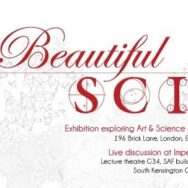Beautiful Science
Posted on Jul 5, 2012

In order to address the growing demand for scientists to share their research in more publicly accessible and engaging ways Beautiful Science project brought together postdoctoral researchers from Imperial College of London and a group of independent artists to transform the visual scientific data obtained with the latest imaging technology into compelling art pieces that would allow observers to connect with the beauty and the science of the research process.
Melissa Belli, one of the artist involved, is a physician and artist that had an affinity for neurons, she started working with them in the print studios of the International Graphics School in Venice, where she studied art for two years. Her work earned her a prize that led to a solo exhibition entitled “Animalcules: an exploration of the microcosm within” with a series of etching and engravings based on semi-abstraction of cellular imaging, that was shown in an installation with MDF frames that were modeled in 3D architectural software to mimic clusters of cells. During the development of this show Melissa was residing in London and seeking source material from Imperial College of London Facility for Imaging by Light Microscopy. Martin Spitaler, facility manager, collaborated with Belli in this project and later invited her to participate in Beautiful Science.
At the onset of the project researchers and artists met to share their work and express their interests in collaboration. Melissa’s affinity for neurons resonated with Eric Dubuis’s work with lung neurons, especially vagus nerve sensory neurons implicated in airway inflammatory response and the cough reflex. These cells are being studied as a new promising target for the development of drugs to treat cough and inflammatory lung diseases like asthma and emphysema.
Eric provided Melissa with a library of microphotographs from his work. She combed through the images and chose two, she then started a process of digital modification, layering, filtering and reformatting that took months. In the mean time she researched ways of fabricating the pieces. She wanted to work in metal but wanted also to make something different and large. Initially she had wanted to transfer the images onto polished mirror grade stainless steel, but after much research costs and technical difficulties, that avenue was closed.
With a background in etching and printmaking, Melissa Belli was brought back to the traditional etching metal copper.
Furthermore, by using the etching medium, which has been compared to alchemy for its use of acids, formulas, and metals, she sought to draw a parallel between the methodology and precision of scientific research protocols and the meticulousness of creating an oversized etching.
She started her artwork at Josephine Press in Los Angeles, California under the guidance of master printmaker John Greco. The largest possible photoetching plates were ordered at 61 by 91 centimeters, specialists were consulted, materials were ordered in unusual quantities, facilities to process large etchings and produce large films were contacted, plates were developed, submerged in acid in large etching tanks, images printed, plates stripped, polished, inked, sealed, framed, crated and transported. With every step taking endless preparation, tests, adjustments and very often errors, which in some cases greatly contributed to the final product.
In the end four pieces were presented by Melissa Belli at the Beautiful Science exhibition together with the works of ten other artist and ten other scientists. The exhibit took place at the Brick lane gallery in the summer of 2012 and was success.
In Pneumotaxix burst, a diptych of a copper plate and its print, we see on the lower left side of the image, a convex reticulated structure depicting a sensory neuron’s body from the nodose ganglion of the vagus nerve trunk; axons extend in an explosive pattern. The globular structures are transverse sections of dendrites and the smaller points are an abstraction of neurochemicals released during stimulation. The image is striking due to its medium, size and momentum, the explosiveness of the image and the complexity of its texture and spaces. The image communicates the power, vitality and speed of neuronal communication in the autonomic nervous system and the effects of stimuli on vagal respiratory afferent pathways mediating the cough reflex.
In Somata Fragments we see a neuron’s body in a process of fragmentation which reflects the myriad stimuli, inputs and outputs that neurons have the capacity of transmitting and analyzing to create our complex bodily reality.




